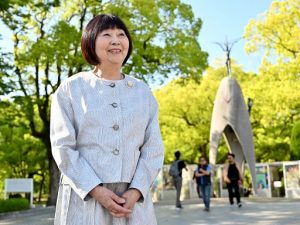Hiroshima Voices: “No Nukes, No War” Tomiko Kawano, 80, A-bomb survivor, Naka Ward, Hiroshima
May 11, 2023
Sadako wanted to live
by Miho Kuwajima, Senior Staff Writer
Sadako Sasaki, who experienced the atomic bombing at the age of two and died of leukemia 10 years later, was Tomiko Kawano’s classmate at Noboricho Elementary School, in Hiroshima’s Naka Ward. Spurred by the desire to do something for Sadako, Ms. Kawano and her fellow students from the sixth-grade ‘bamboo class’ began a fundraising campaign that eventually spread around Japan, leading to establishment of the Children’s Peace Monument in Peace Memorial Park on May 5, 1958. With Sadako’s desire to live in mind, Ms. Kawano shares with the public her experiences in the atomic bombing. She also is busy with the work of sending notebooks made of recycled paper cranes to elementary and junior high-school students overseas.
Click here to view the video
Whenever I pass in front of the Children’s Peace Monument, I catch sight of overseas travelers and students on school trips surrounding the statue and offering paper cranes. People worldwide make the visit to Hiroshima not only to mourn Sadako but also to deliver paper cranes they have folded as a wish for peace. I have a strange feeling about my role as being part of the impetus behind this activity and a strong sense of responsibility as someone who has survived these 80 years.
I experienced the atomic bombing in the area of Ushita-cho (now part of Hiroshima’s Higashi Ward), 2.3 kilometers from the hypocenter, when I was three years old. My oldest brother, a third-year student at First Hiroshima Prefectural Junior High School (now Kokutaiji High School), died the day after the bombing at a national school to which he had been transported, crying out the words, “So disappointing!”
I was in the same class as Sadako from the second through sixth grades at Noboricho Elementary School. She was fast and the only one of us who could vault over seven stacks of jump boxes. We played together, jumping rope and doing exercises on the horizontal bar, you name it. But in February when we were in the sixth grade, Sadako was hospitalized. Our homeroom teacher reported that, “Sasaki experienced the atomic bombing when she was small.” I specifically remember thinking with horror that I could also fall ill from an A-bomb disease. At that time, more than one-third of my classmates were A-bomb survivors. The aftereffects of the atomic bombing had already been linked directly to death.
My classmates and I formed what we called the “Solidarity Association” and continued to visit Sadako in the hospital even after elementary school. In her hospital room, we found paper cranes hanging from the window frames and around her bed. Working desperately to make origami cranes from medicine and candy wrappers, Sadako explained that, “I’m folding them because my disease isn’t getting any better.” Purple spots were visible on her arms and legs. It was excruciating for me to be there, and soon I began to visit her less frequently.
After Sadako’s death, the fear that we could suffer the same fate and our regret about not continuing our visits to the hospital motivated members of our ‘bamboo class’ to campaign for establishment of the Children’s Peace Monument. Both Sadako and my brother wanted to live, but the war took everything from them. My mission is to convey their stories to children.
In 2018, I initiated the Origami Crane Notebook Project with volunteers from small business associations. Thus far, we have donated more than 6,600 notebooks to elementary and junior high-school students in Europe, America, Asia, and Africa. In the belief that the notebooks made from the recycled origami paper cranes will serve to foster the spirit of peace in children, we aim to continue the project over the long term.
The persistent slaughter of people in Ukraine and the Sudan is truly heartbreaking. I want leaders who gather for the Hiroshima Summit of the G7 (Group of Seven industrialized nations) to listen firsthand to the stories of A-bomb survivors. I hope they come to understand deep down that anyone could suffer the horrifying experience of nuclear devastation so long as nuclear weapons exist on earth and are able to turn that understanding into political action.








